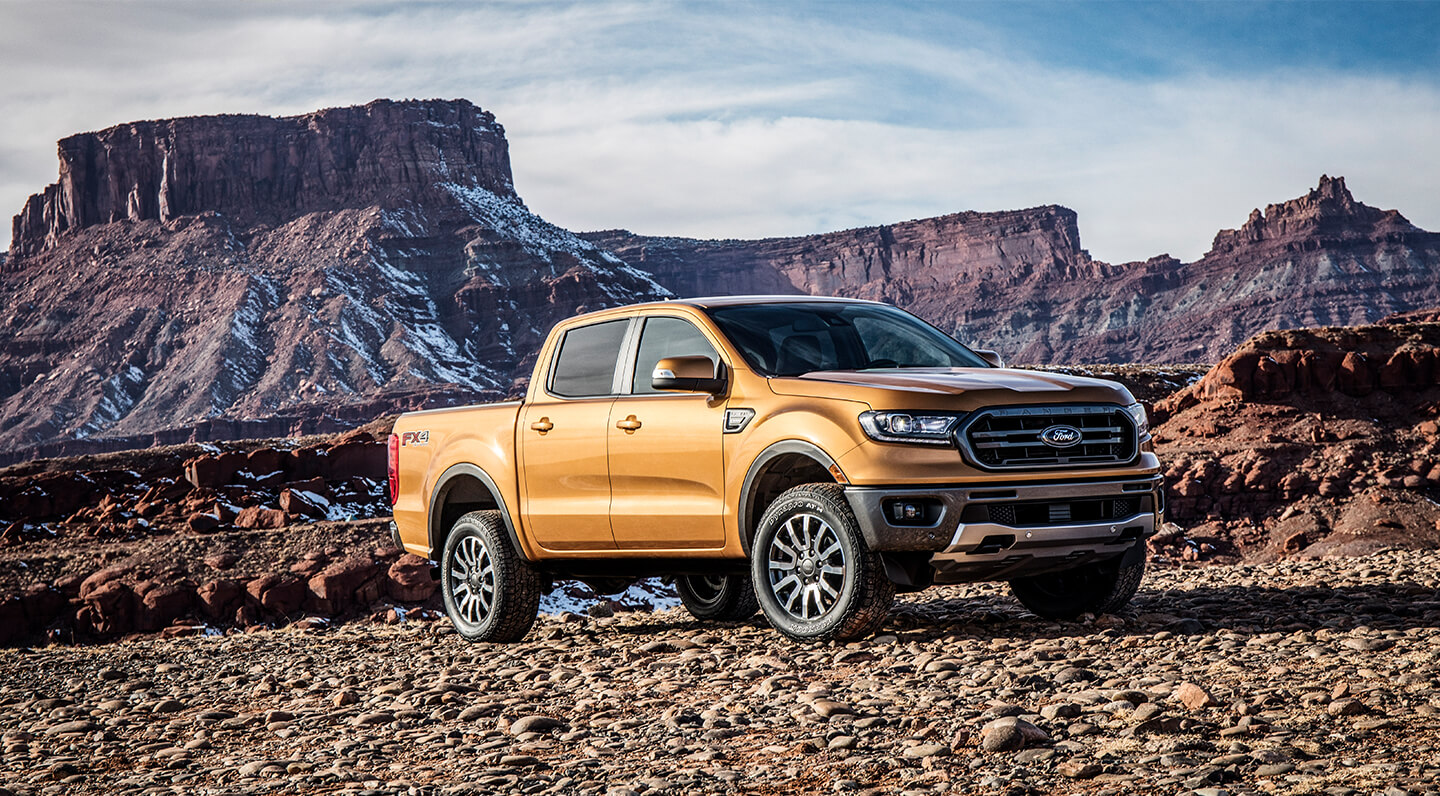
Tested: 2019 Ford Ranger SuperCrew 4×4 Review
Back in the 1980s, the Ranger made do with a pokey 2.8L V6 as the top engine. But this rig had the edge over much of the competition in terms of 4-wheel drive capability. That’s because it used a mini-version of Ford’s Twin Traction Beam front suspension. In 1990, the Ranger received a stronger Dana 35 TTB and the potent 160 horsepower 4.0L V6 joined the lineup too. The suspension had decent wheel travel in stock form and could be modified to be far more capable. Those early Rangers joined the Jeep Comanche as well as numerous solid axle Toyotas as the compact trucks you’d regularly see out on the trail.
Later, the Ranger switched to a conventional A-arm IFS and was offered with an FX4 Off-Road package. The special FX4 Level II (2003-07) used a strong Ford 8.8 rear axle with a Torsen diff, 31-inch tires and upgraded dampers. It was a great little truck. The general public thought so too because Ford’s Ranger held the best-selling compact truck title for more than a decade. However, by 2011 interest for the Ranger and compact trucks, in general, had slipped and the truck was put to pasture.
Now, after 8 long years, Ford fans have a new small pickup. Yes, the Ranger has finally returned. And though it’s a little late to the mid-size party—the segment is thriving with sales topping about 500,000 trucks each year. The mid-size truck market has gone from dull to dynamic in just a few years.
The good thing about launching into a mature market is Ford’s engineers benefited by examining the strong and weak points of the competition. So, did they come up with a winning formula? We wanted to find out, so we borrowed a $43,695 Ranger Lariat 4X4 and pounded it through our battery of tests including a 300-mile on-pavement slog on and off LA’s freeway system. We also did a day of four-wheeling at our local off-road park. Let’s see how it faired.
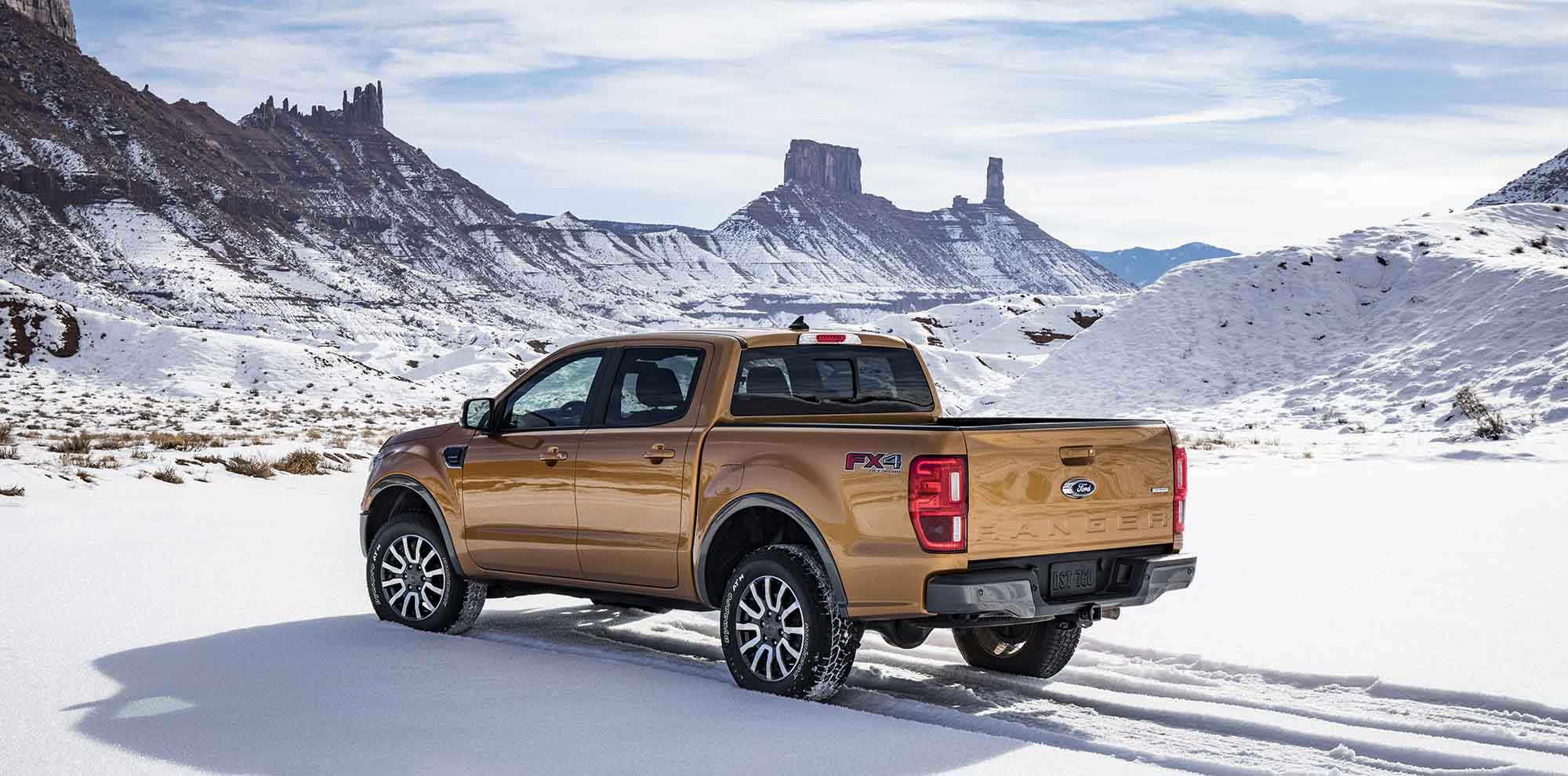
The Hardware
The mid-size Ranger may indeed be “new” here in America, but a version of this truck has been available since the 2012 model year in other parts of the world. So, this isn’t precisely an all-new truck. Ford says the Ranger, which rides on a 126.8-inch wheelbase, has been updated and upgraded with a modified frame. The Ranger’s handsome sheet metal is generally the same as that of the global Ranger, but it wears a new grille and headlamps. But the most significant upgrade over those overseas models is in the powertrain department.
Every Ranger uses a healthy 270 horsepower turbocharged Ecoboost 2.0L four-cylinder with 310 lb-ft. of torque at 3,000 rpm. And, it’s paired to a 10-speed automatic with a manual shifting and an electronically controlled transfer case with a 2.717:1 low range. That 10-speed has an incredible gearing range. First gear provides a stout 4.69:1 ratio with overdrive gears in 7-10th gears. Up front is a traditional coil-spring double wishbone suspension that houses a Dana Advantek 7.5-inch differential. In the rear, it is no surprise that Ford uses a pair of leaf springs to suspend the new 8.6-inch Dana Advantek solid axle. On our truck, both diffs were open and used 3.73:1 gears—the only ring and pinion available. That makes for a good crawl ratio of around 48:1.
Our Lariat model is the top trim above the standard XL and mid-level XLT. And that package includes 18-inch wheels, leather seating, and a touch screen infotainment system with Sync 3. Our truck added option group 501A ($1,795) that adds a Bang and Olufsen audio system, a tech package with adaptive cruise control and navigation, rain sensing wipers, remote start and a wiper de-icer. It also had a $495 spray-in bed liner, which we dug. But the $635 chrome running boards are an option we’d gladly remove as well as that chrome appearance package for $795—more money we’d have left on the table.
At the scales this Ranger weighed 4540 lbs., which is precisely the same number we saw for the last V6 Colorado Z71 we tested and about 200 lbs. lighter than the Gladiator Sport we drove a month or so ago. When equipped with a $495 tow package as ours was, the Ranger can handle a 7,500-lb. trailer. Certain Jeep Gladiator and Chevy Colorado models can tow slightly more. Our truck’s payload of 1,413 lbs. is at the lower end for a Ranger as some models can top 1,800 lbs.
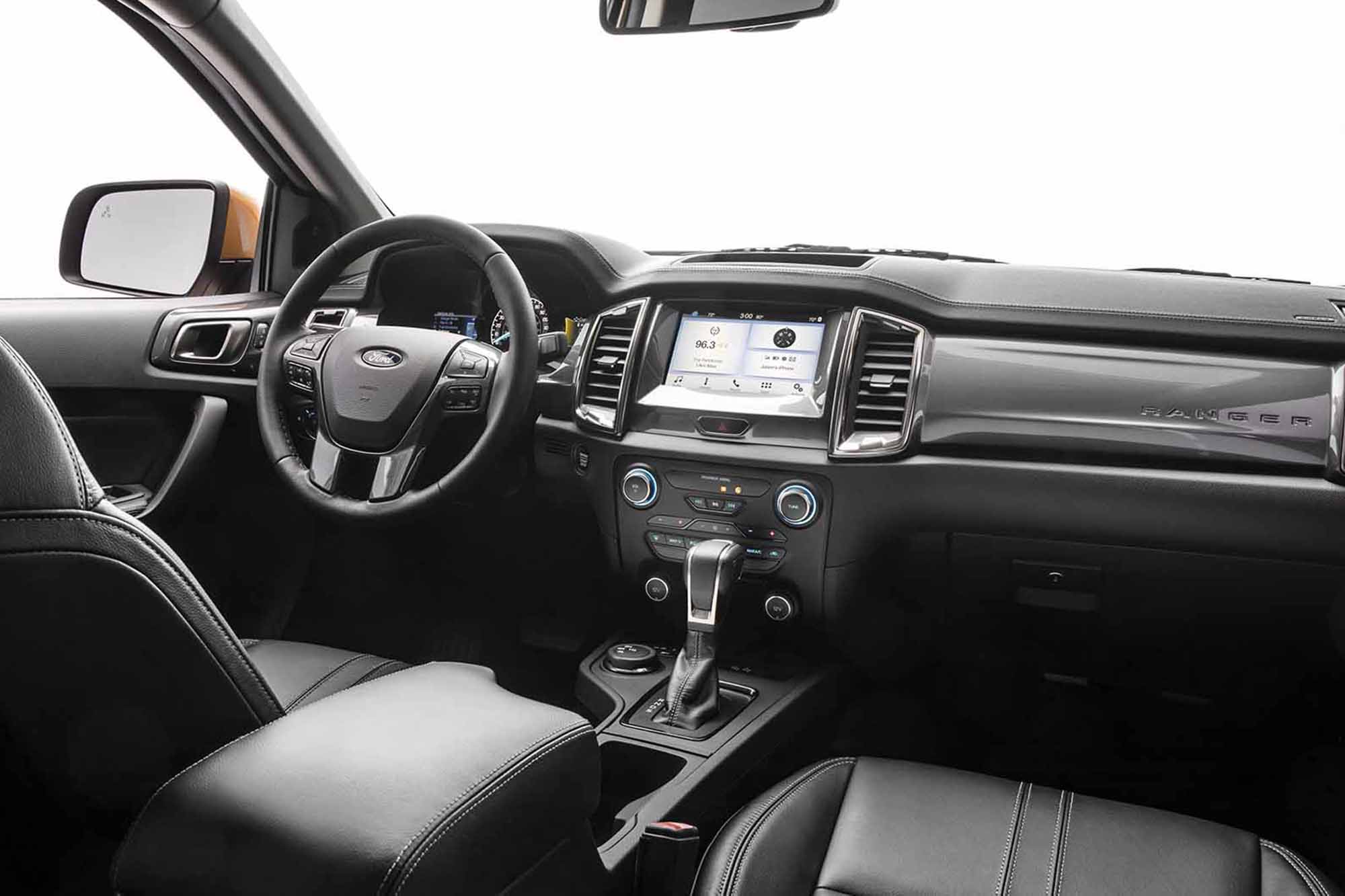
The Ranger’s interior uses trim and switchgear that’s common to other Ford family vehicles. But it just doesn’t seem as new and up to date as some competitors. And the small rear seat keeps this from becoming a road trip favorite.
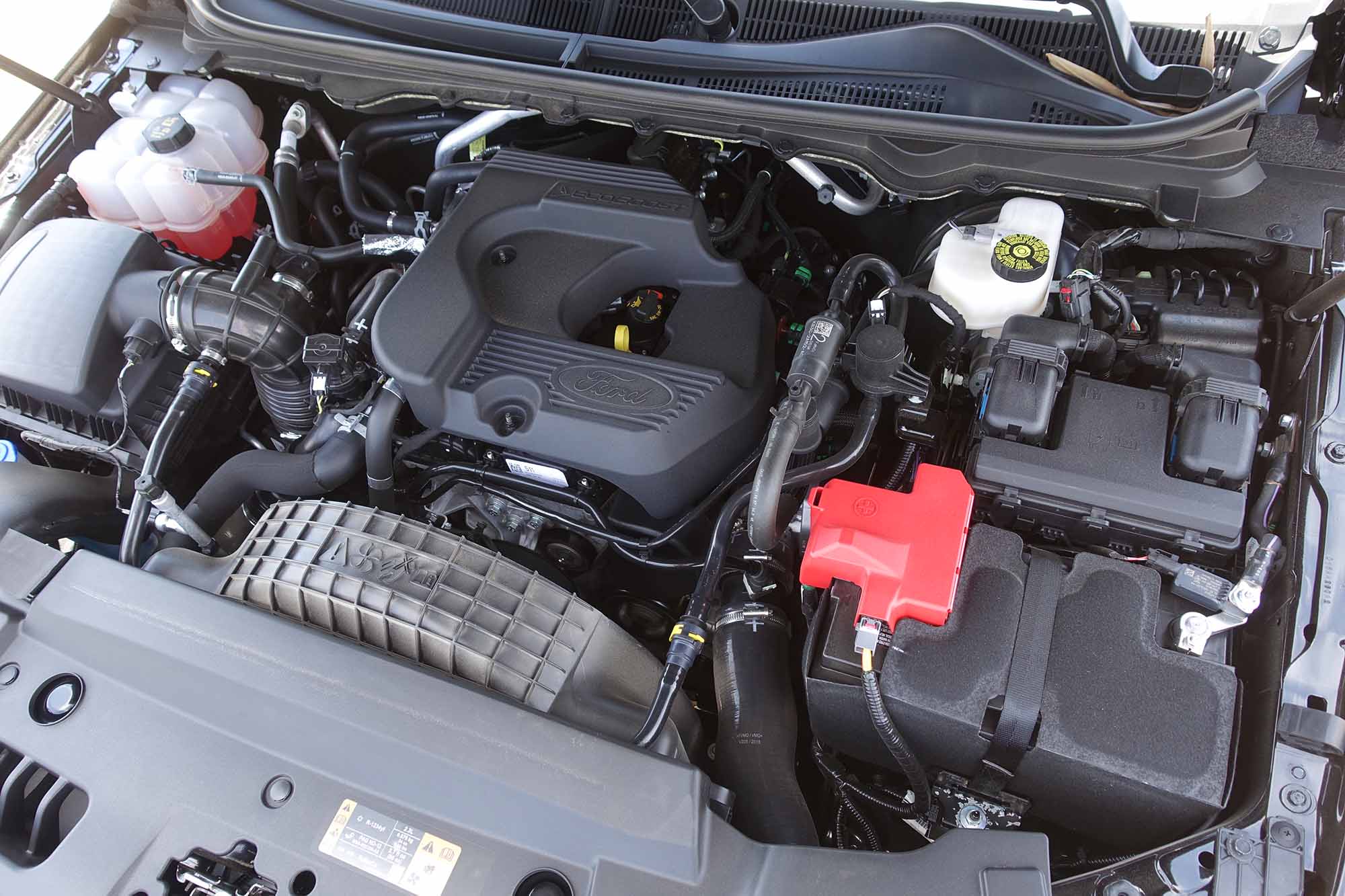
The best part about the Ranger is its powertrain. The 270 horsepower turbocharged four-cylinder is potent and very torquey with 310 lb-ft available down low. The excellent 10-speed automatic does a great job of making that power available all the time.
On the Street
The best part about the new Ranger is that powertrain. The turbo 2.0L absolutely rips. A recent Car and Driver test recorded a 0-60 mph time of 6.5 seconds. There’s a sport mode on the transmission that really wakes up the truck. Amongst all mid-size trucks, only the Colorado’s 306 horsepower V6 and 8-speed automatic were quicker in their testing at 6.1 seconds. Of course, the four-cylinder just doesn’t sound as good as Chevy’s smooth V6. And the turbocharger makes a loud “whooshing” at wide open throttle. Still, the combination of the 10-speed’s excellent gearing and generous low-end torque make this truck not only zippy off the line, but a comfortable cruiser no matter how steep the pavement grade.
At 70 mph the Ranger’s four-cylinder spins right around 1,800 rpm in 10th gear. And the torque means it doesn’t have to downshift very often. On the steepest grades, we saw the revs increase to just 2,000 rpm in 9th gear—and stay there. In other words, we experienced no hunting for the right gear. The only real complaint about highway driving is the cruise control functions. These buttons are tiny and positioned in a very awkward space on the steering wheel that required taking our eyes off the road to operate. On the freeway, the ride was a bit bouncy compared to some mid-size trucks. Though, around town, it wasn’t noticeably rougher than other rigs in this class.
The Ranger’s exterior dimensions are close to those of other mid-sizers. But somehow, the Ranger seems much narrower. It drives small. That’s certainly an advantage in an urban setting as well as an off-road trail. It’s a quick and nimble machine hustling through traffic.
But that interior felt a bit tighter than those in the class. And the Ranger’s rear seat is perched high with barely enough headroom for our 5’11” frame. This would probably not be the back seat to choose for a road trip with tall people. The Ranger’s interior seemed dated too. Although we liked the old-school handbrake lever, that real estate probably could have been put to better use.
The Ranger carried an EPA fuel economy rating of 17 mpg city and 24 mpg on the highway. At the end of our tankful, the Ranger returned a solid 21 mpg. That’s right in line with other mid-size trucks we’ve tested. The last Colorado we drive returned 20.9 mpg. And the Gladiator we tested recently returned exactly 20 mpg as did a Tacoma Sport.
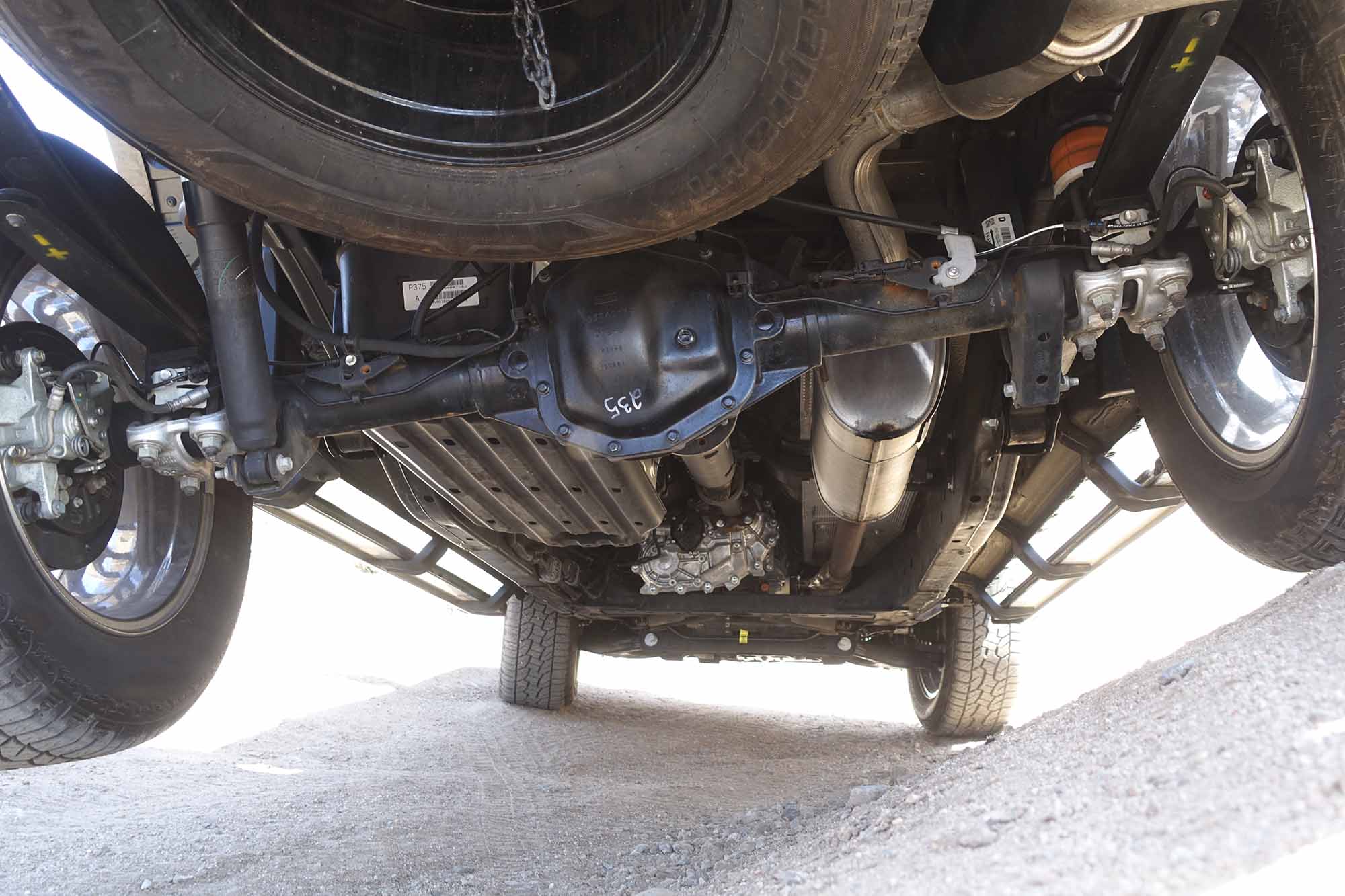
The rear 8.6-inch Dana solid axle houses 3.73:1 gears and is suspended with leaf springs (a single leaf plus overload per side) and appeared to offer less articulation than other mid-size trucks we’ve tested. Our Lariat had an open differential in the rear, which certainly didn’t help its off-road capability.
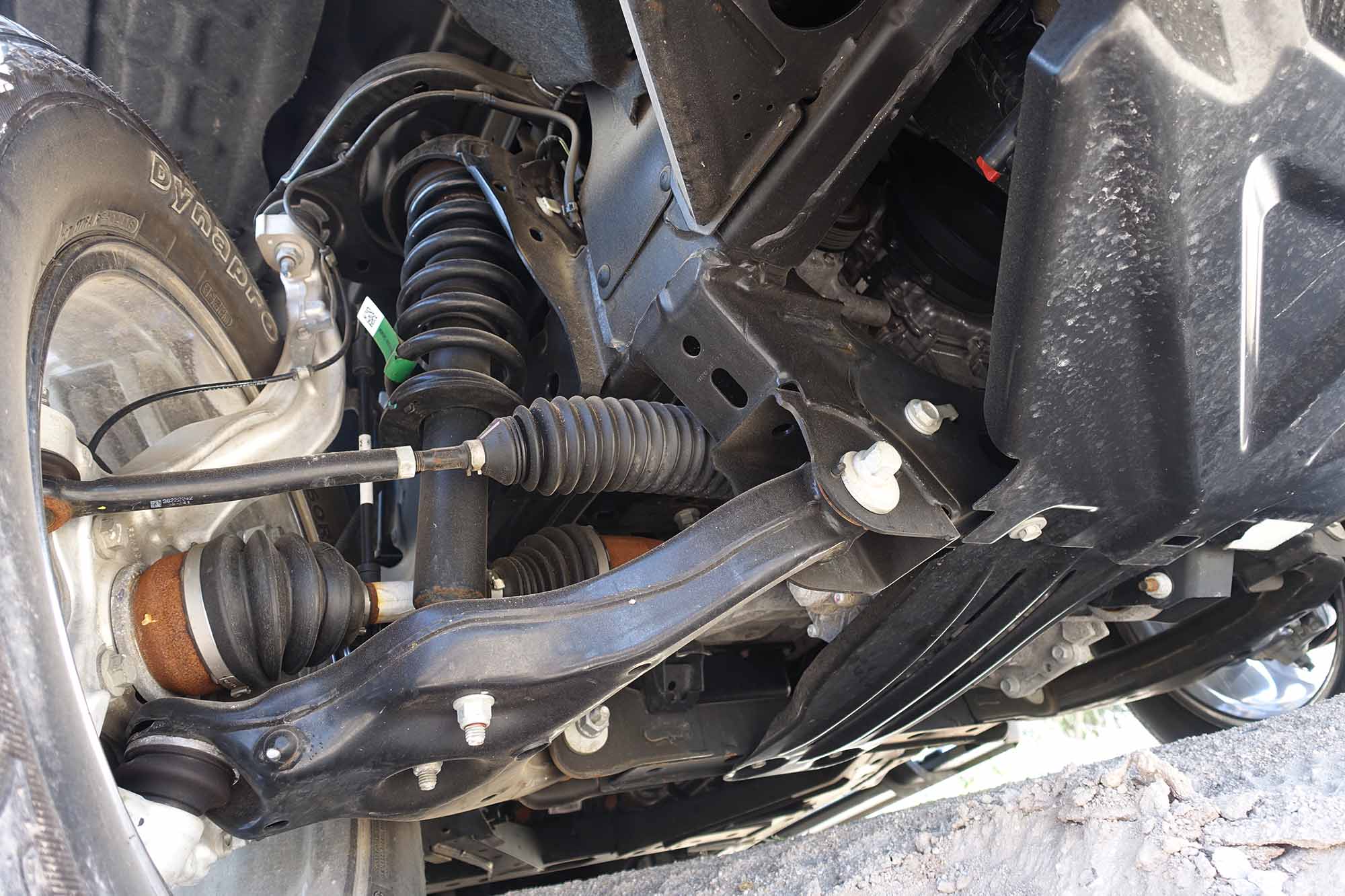
The Ranger’s coil-spring double wishbone IFS uses a 7.5-inch open Dana front diff. Wheel travel seems to be on par with that of the Chevy Colorado—but with noticeably less suspension movement than the Jeep Gladiator. No surprise there.
On the Trail
The Ranger carries with it some historical off-road capability. But unfortunately, our test truck wasn’t equipped with the FX4 package, a grouping of options that include an electronic locking rear differential. Still, at first glance, the Ranger seemed to have the right stance for moderate off-road travel.
The front air dam lip is 11 inches off the ground and pulled back close to the front wheels to maximize clearance. We measured an even 9 inches at the lowest points under the front and rear of the truck, which isn’t too bad. And driving around the park in 2WD on the mildest trails, it was clear the Ranger’s tidy dimensions provided excellent approach and departure clearance.
But when we locked the Ranger in low range with the 4WD knob and pointed its nose toward the dirt, it was clear the suspension hadn’t been designed for serious articulation. We used up all the available wheel travel very quickly. And with an open diff at each end, the Ranger was easily marooned with a tire in the air more rapidly than some of the competition. On our hill test section, the Ranger could only handle the most moderate climb. And even then, the route required a bit of momentum with the traction control working overtime. It wasn’t an elegant pass.
In the sandy washes around the park, the Ranger was much more in its element. Simply turn off the traction control, put the transmission in sport mode and have fun. The truck’s excellent powertrain allowed us to slide the truck around a bit and really carry some speed through the deep stuff. Similarly, the Ranger was an enjoyably smooth companion on the park’s higher speed fire roads.
But when we finally arrived at our most difficult rutted mogul section of trail, the Ranger had no hope of completing it. The undulating terrain quickly maxed-out the Ranger’s wheel travel and without a locker, it wouldn’t move. The traction control system is designed for slipperier terrain and requires quite a bit of wheel spin to engage. So, the wildly spinning wheels would slide off the obstacles before diverting torque to the tire with traction. And that meant four-wheeling in the really rough terrain was unpredictable and we nearly caved-in the front bumper to prove it. So, we backed off this area and explored easier trails in the park. Would this trail section have been more accessible with Ford’s FX4 Off-Road package as part of the options list? Perhaps. The locking rear differential could have made a real difference here. And we’d be happy with the package’s off-road tuned dampers, air dam delete, electronic terrain management system and more.
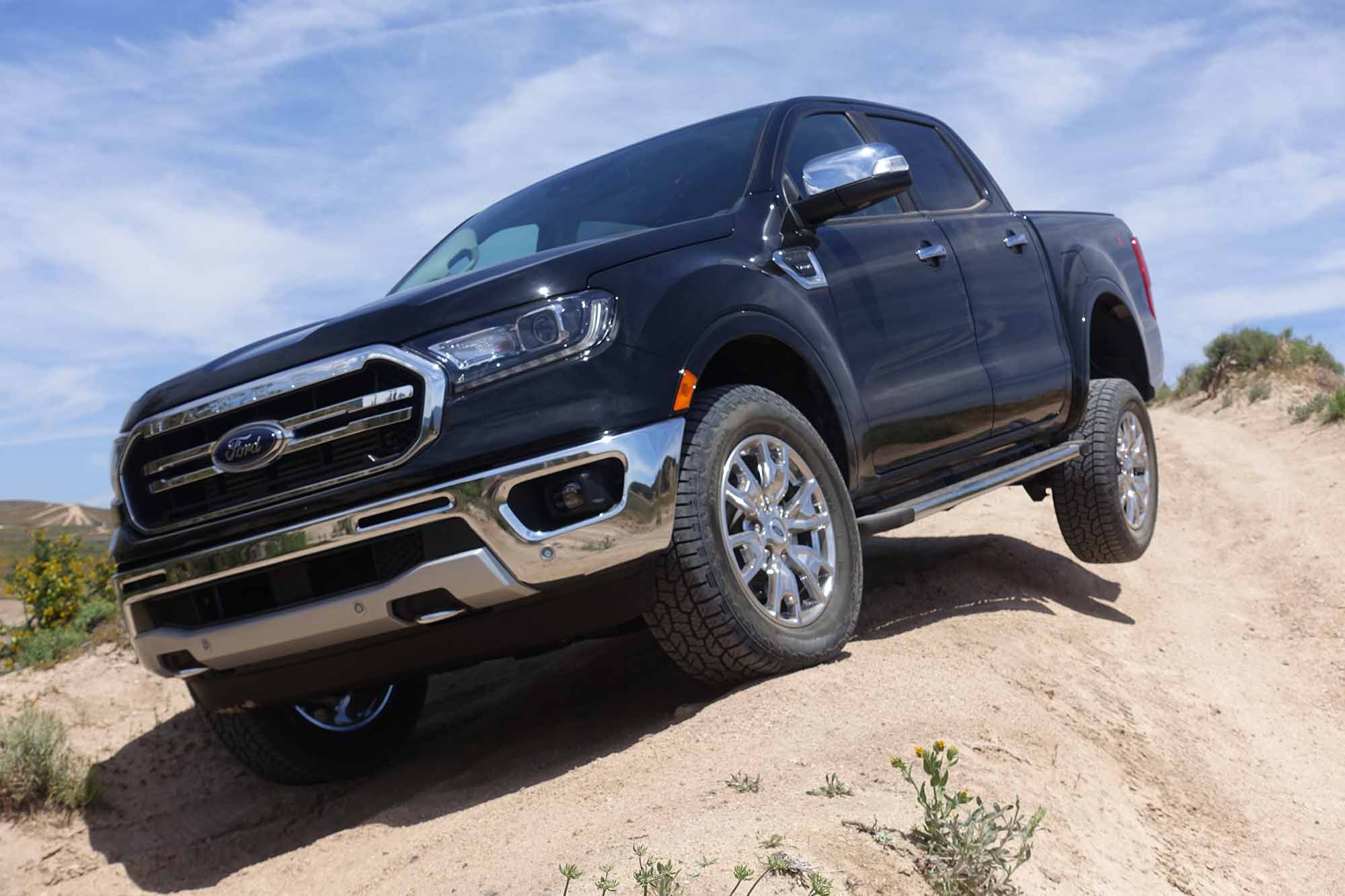
The Ranger wasn’t the trail hero we’d hoped it would be. But it does have potential. Ford’s FX4 package would improve its performance in the dirt. However, to really match the heavy hitters like the Tacoma TRD Pro, Colorado ZR2 and Gladiator Rubicon, the Ranger would need more wheel travel and some suspension lift to fit larger tires. There are already some aftermarket suspension systems available for the Ranger. We’d like to test one after it had a bit more specialized off-road equipment.
The Bottom Line
It’s been far too long since the 4WD enthusiast has been able to buy a new Ford Ranger. And we’re glad it is back. The Ranger’s powertrain both in terms of power delivery and fuel economy put this truck near the front of the mid-size class. But its interior is a bit dated, and its off-road performance was closer to the back of the pack. Our Lariat model stickered just north of $43,000. That’s not cheap. For comparison, Colorado ZR2 starts at under $42,000. Can you guess which one we’d rather have?
For dirt driving the Ranger’s $1,295 FX4 Package is a must. Since the Lariat trim isn’t really worth the extra dough to us, we’d skip the fancy stuff altogether, add the FX4 directly to the base Ranger XL, and leave the dealership with a solid truck for less than $33,000. Ford is considering a move to bring over the sweet Ranger Raptor that’s for sale outside the US. That would most certainly be a Ranger worth waiting (and saving up) for.



2